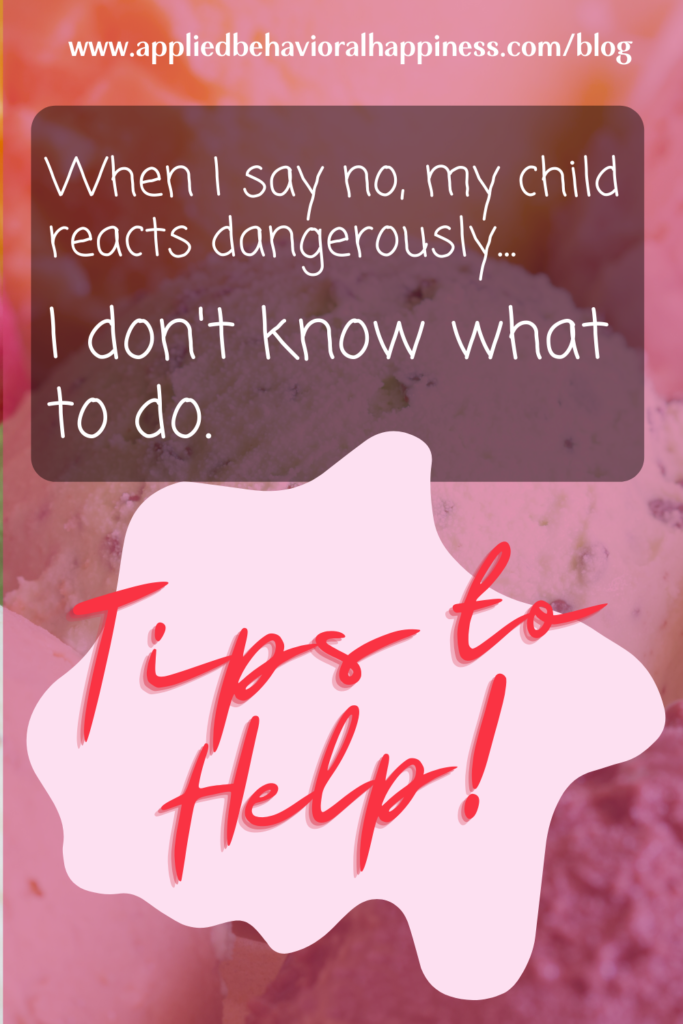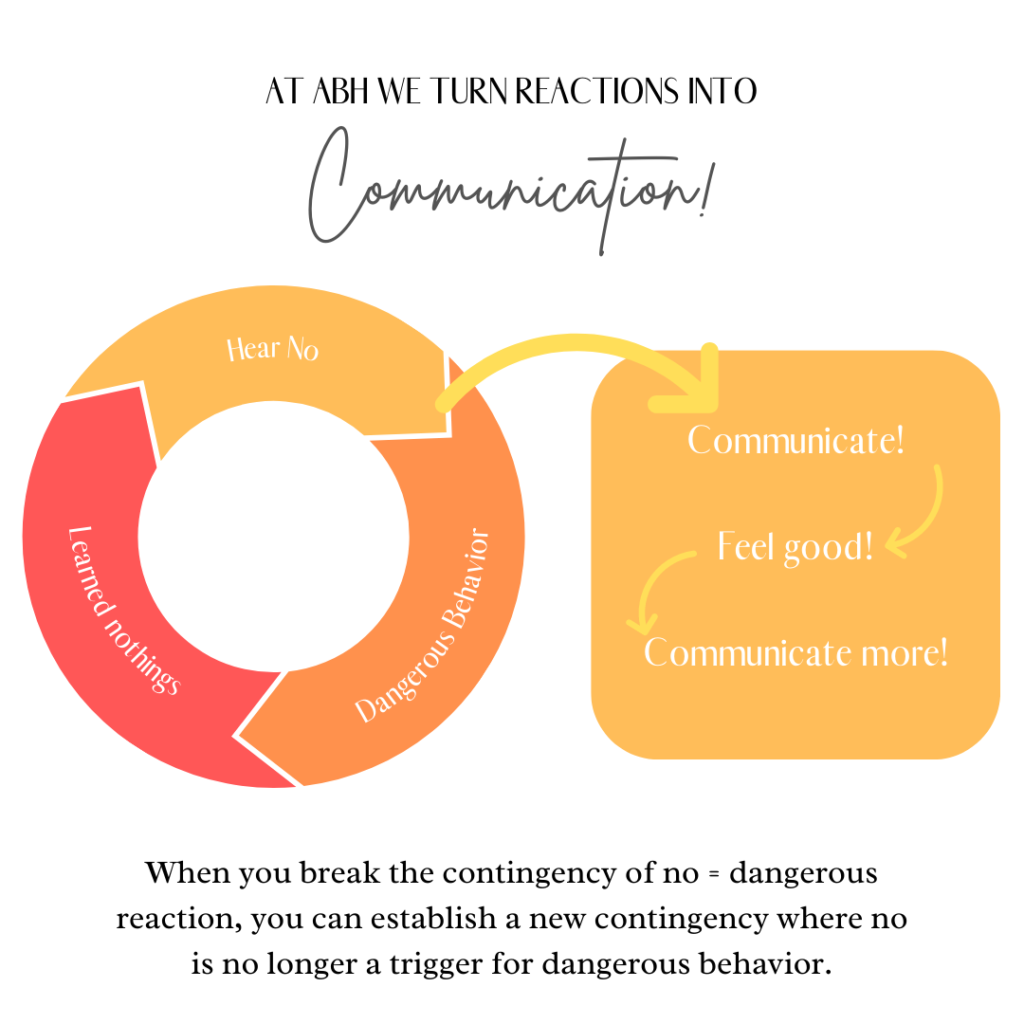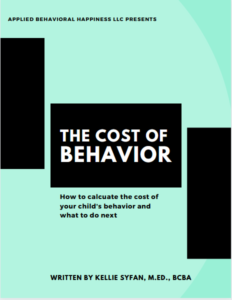Children who don’t accept no can have some extreme reactions to hearing this small word. When saying no triggers dangerous behavior, you will experience everything from perseveration and whining to extreme tantrums and crisis-level escape (I don’t want it), access (I want it), and attention (I want you) behaviors. Your child is upset, and you are stuck walking around on egg shells. What can you do? Let’s talk about it!
What does accepting no look like, and when is that a good or bad thing?
Nothing is ever 100% good or 100% bad: I’m sorry to burst your bubble if this is new news to you, but that’s the world we live in. It’s a world of beautiful nuance and debilitating details wherein the devil lives. Accepting no well has a good and a bad side.
On the good side, kids who accept no are able to let things go, may be described as “water off a duck” type kids, and can be really flexible about change. These kids tend to be happy and go with the flow.
On the bad side, kids who accept no too readily can’t stand up for themselves, don’t stand for injustice, and accept the status quo even when it’s harmful to themselves or others.
What does NOT accepting no look like, and when is that a good or bad thing?
Just like with accepting no, not accepting no can be a good thing or a bad thing. It really depends on the circumstance and the context–and it’s worth talking about.
On the good side, kids who don’t accept no can confidently stand up for what they believe in even when they are the underdog in the battle. They may excel in leadership and innovation, and might be really exceptional problem solvers.
On the bad side, kids who don’t accept no may engage in potentially dangerous behavior when they hear “no” whether that is throwing a massive tantrum, melting down, running away, hiding, or becoming aggressive. They may lose friends because they are too bossy or because they hurt other kids when playing too roughly. This is where we are focusing today.

What can you do if you know that saying no triggers dangerous behavior?
When we start with new clients, we provide and require they take a Safety Care for For Families Crisis Prevention and Intervention course. I am a certified Safety Care and Safety Care for Families instructor through Quality Behavioral Solutions. This training is focused on recognizing triggers and using strategies to help avoid crisis and increase communication.
A lot of what I teach in the class could be conceptualized as strategies for co-regulation and strategies for recognizing and honoring why the behavior is occurring before attempting any changes. But what if you are not a client of ours and don’t have access to this amazing training?
Here are three things you can do:
1. Avoid the no using imagination + choice: You can say the word NO or you can empathize, play, and give a choice. Sometimes this is all you need to help kids break the cycle of hearing no and flying off the handle. Here are some examples:
-
-
- They ask for ice cream for dinner: “Ah man, wouldn’t that be awesome to have dessert for dinner? I’d have cake if I could, the biggest cake in the whole wide world with TONS of frosting and sprinkles! I’m going to draw my dream dessert. We are having tacos or taco salad for dinner, which are you going to have?”
- It’s time to leave the pool and they are not having it: “You want to stay in the pool, that’s fair. I wish we could stay in the water forever like a couple of dolphins, splashing all day! It’s time to get out now, I have a warm green towel and a warm red towel, which would you like?”
-
2. Prepare the area for success: If you know that saying no triggers dangerous behavior and you are about to present a big no, consider modifying the environment to set them up for success. Here are a few things that you can do to set them up for success and safety:
-
-
- If they run out of the door when upset, lock the front door before presenting the no. Consider having the child safety locks on if you are in the car
- If they fall down to the floor, tell them near a couch or on carpet so that they don’t hurt themselves on hard flooring
- If they throw things, make sure that they have lots of soft things to throw (balled socks, pillows, scarves, and blankets can all do the trick) and that hard objects are harder to reach
-
Note: These may seem simple or “obvious”, maybe even cheeky–they are not. These are no non-sense ways to increase safety when saying no triggers dangerous behavior.
Also of note: if you are between crisis behavior (throwing a vase at a wall) and inappropriate but not dangerous behavior (throwing a balled sock at a wall), choose the safe version for now and THEN worry about stopping throwing all together.
If you try to help them learn a new behavior without giving them a safe alternative for the current one, you’re going to have a lot more destruction along the way.
3. Create play around choices: Role playing good choices can be very helpful to learning to make these good choices! Also, don’t forget to role play that you love them no matter what, even if they make a choice that you wouldn’t prefer. This can look like:
- Having a teddy bear hear no from you and then choose to get some space and take deep breaths
- Having a train get stuck on the tracks and helping him ask for help to move through the problem
- Pretending a toy wants a cookie, tell them no, have them throw a big dramatic fit, and talk through how you are there for them and love them no matter what
4. Look into alternative forms of communicating no: For example nonviolent communication (NVC) includes a tenant of not saying no but rather stating the need behind the no that would not be met if you said yes. I know that’s a little convoluted, but it’s a neat concept. Instead of saying “no, you can’t have that toy”, I might take a moment and consider what need I am caring for by with that no and express that instead:If I bought you that toy, I would not be addressing my need to provide opportunities for budgeting and money education.Am I am expert in this subject or type of communication? Not yet. Here is a video on nonviolent communication that may be helpful if this interests you (it’s 3 hours long, so be prepared to split it into pieces).
What do you do at ABH if saying no triggers dangerous behavior?
Our programs are based on research, both inside and outside of our practice. Much of what we do is based on the work of Dr Gregory Hanley and his team as it pertains to Practical Functional Assessments (PFA) and skill based treatment (don’t hesitate to click the links: they give away a TON of their research and materials for free). We have refined these protocols to best fit the families we serve in general and customize them to fit the goals of each family.
When we see a challenging behavior, we first ask why is that
behavior occurring, why does saying no trigger dangerous behavior? Do
they not know a better way? Do they want out of something? Are they
trying to get something? Are they trying to access someone? Are they
generally overwhelmed and in sensory overload? Is it a big mix of all
of these?
Unlike many ABA companies, we are neither interested in taking months of data to get a hypothesis, nor interested in hammering down the “one true function”. Humans are nuanced, and there is likely a synthesized function (meaning a mix of things) going on around each instance of behavior. As well, if you are taking the time to call us, you don’t have time to wait on months of data collection for support: you need it NOW.
So once we have the keys around the why, we immediately give kids a “magic word” (or phrase or signal or icon or sign or whatever is best for the child, often with the consultation of an SLP) to use when

we are around that allows them to get what they want. Then, we get annoying. We start poking the bear, very gently and help them use this new magical get-what-I-want trick.
At first, kids act a little suspiciously but soon they are often howling with laughter as they use their word to get their way. They have solved the puzzle! They don’t have to feel the icky feelings and explode; they can COMMUNICATE and it is empowering–you can see it on their faces and hear it in their laughter.
This breaks the cycle of: “no” = AHHHHHHH! I’M LOSING IT! YOU HATE ME! I’M ALWAYS WRONG AND NO ONE LOVES ME!
and turns it into: “no” = communication works and, holy moly, it feels good!
Once that cycle is broken, we can start to work on more sophisticated communication, how to handle when asking nicely still doesn’t work, and working through difficult, big-feeling moments.
In short: I have the most beautiful job in the world, and you will have a hard time convincing me otherwise.
Hey, quick pause: Does that last bit resonate for you, the “no” = breakdown thing? Is it a little too close to home for comfort? If so, I am so sorry that you and your child are going through this. That has to be exhausting, and I can’t imagine how hard you are working to help them navigate this bump in the road. Know that we are here to help, you can reach out any time and check out the next section below.
How do I get help if saying no triggers dangerous behavior?
The first step is to schedule a free discovery call with me, Kellie, the owner of ABH. Of course there are other people to talk to and get services from (like OT, psychologists and therapists, and parenting coaches)–reach out to them too! Find the best fit, it’s okay if it’s not us. I hope it is, but I’m not going to force it: this is your child we are talking about here and there is nothing more precious.
Just know we are here for you whenever you’re ready to start making a positive difference for your family. Are you ready now? Click the button above to schedule your Discovery Call!

Get Kellie’s eBook — for free — and get free resources sent to your inbox weekly! Get access now by signing up below!
